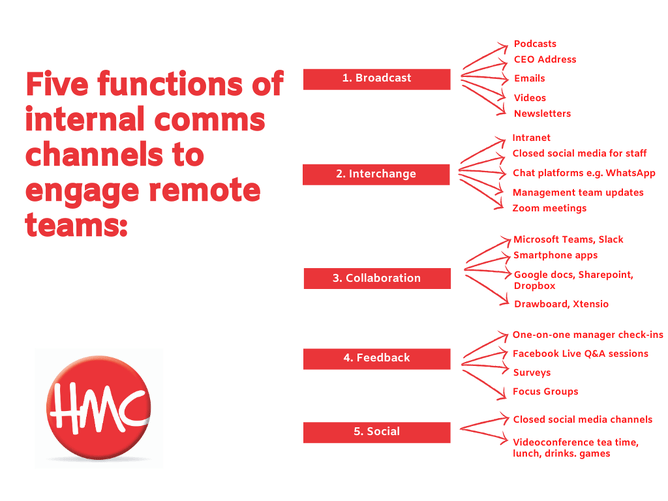Five essential functions your remote working comms channels must perform
Well, we are a few weeks into our COVID-19 lockdown here in New Zealand and by now all managers have discovered the challenges inherent in managing remote teams. Part of that challenge is the communication side of your day-to-day activities.
We’ve been talking to a lot of colleagues during this time and it seems companies fall into two camps. The first are companies that already nail their internal communications and were able to transition seamlessly into remote working. The second camp are those companies without good internal communications channels, who are now discovering how important staff communication is to reaching company goals together.
Any weaknesses in your internal communications will be magnified once the remote working challenge is thrown in the mix.
In thinking through the various channel options available to managers to communicate effectively with their teams during remote working, I believe you’ll succeed if you have channels that allow you to perform five essential functions:
1. Broadcast
You’ll need good channels in which to get important messages out to your team when you are managing them remotely. And you may find you need to formalise this more than you would have when people were under one roof. The communication that used to happen ‘by chance’ doesn’t any longer. So, you may need to ‘broadcast’ important messages more often to keep everyone on the same page.
Great ways to do this is through the CEO or leaders doing a formal address from time to time. Of course, there’s always email, but be careful not to send too many of them as you’ll find people ignoring them.
Think of some innovative, but inexpensive, channels you could use to broadcast important messages such as in a video or through a podcast.
And, of course, the old company newsletter is always a standard channel that works well. Just keep it regular, short and full of photos and visuals to encourage readership.
2. Interchange
While broadcast communication is important, using channels that encourage two-way communication or ‘interchange’ is absolutely essential.
Consider chat platforms like WhatsApp or closed social media channels just for staff. Videoconferencing, of course, is an excellent channel for encouraging two-way communication – just ensure meeting moderators encourage team member participation especially those who are less apt to offer opinions in a team space.
And if you’ve always thought about developing an intranet platform, this just might be the catalyst you needed to finally get that project off the ground. Companies who already had an intranet before lockdown will be happy they did, as it’s a great place to put important notices, but to also encourage feedback and discussions if you’ve got the right tools – like chat and others – integrated.
3. Collaborate
One of the key things we all miss from not being together as teams is the brainstorming, collaborating and ability to bounce ideas off each other.
There are some great collaboration communications channels that can help you bridge this gap. Team tools such asMicrosoft Teams and Slack are great channels to ask quick questions, brainstorm and chat throughout the day when an email seems a bit too formal.
And, of course, document share systems like Google Documents, SharePoint and Dropbox provide platforms where multiple team members can contribute and co-create.
Check out Drawboard if you are missing your office whiteboard. And Xtensio is great for team collaboration around developing plans, presentations and other documents.
4. Feedback
Feedback is critical to gaining ideas for improvement. So, don’t forget to ask for it. The best way to do this is by checking in, one-on-one with your team members throughout the week. No fancy technology can replace this, which becomes particularly important when people lack the contact with others.
If you have a closed team Facebook page, why not try out aFacebook Live Q&A session? Or do something similar on a videoconference meeting.
And of course, you can always send out a quick survey or put together a staff focus group to gain feedback and ideas on how you’re doing with your communication.
5. Socialise
And, finally, don’t forget to encourage the fun part of work. This is something many people miss the most about working remotely. However, if you can keep the camaraderie going, you’ll build further company loyalty, cement values and build high-performing teams.
Consider a closed social media channel that’s only dedicated to fun stuff. Or encourage teams to meet for tea, lunch or late day drinks via videoconference. I even heard of an organisation doing a team quiz night over Zoom.
And just a few quick internal communications tips to remember no matter what channels you are using during remote working:
- Ensure each team member is getting a one-on-one check-in per week.
- For important messages, don’t rely on only one form of communication.
- Back up videos or audio announcements with a follow-up email.
- Distribute notes from important Zoom company meetings to all staff.
- Settle on the communications channels your company will use, ensure all staff know when to use each and how.

